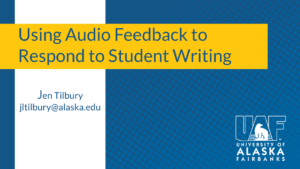Flipped classroom
Case Studies & Strategy
The flipped classroom is one in which, unlike traditional methods, lectures and instruction take place outside of synchronous class time, usually in the form of instructor videos or screencasts, while homework and group activities take place during class. The flipped class model allows students to practice time for applying their understanding of the subject with access to immediate feedback. Instructors also have more time for clarifying difficult material and interacting directly with students. This learner-centered approach can work well, but there are strategies that should be kept in mind when designing both the flipped material and the classroom experience.
At UAF, a Faculty Learning Community (1) was established by a group of pioneering faculty members earlier this year for exploring the flipped teaching modality across disciplines. The website they created is a fantastic resource; it is available at https://flipped.community.uaf.edu.
There you will find information on technology, ideas for classroom activities, potential assessments for flipped material, and a citation list for further reading. Also on this site is a collection of valuable informal case studies written by UAF faculty reflecting on their experience teaching flipped courses. The examples outline what’s worked and what hasn’t.
The flipped modality can work well in many subjects, including STEM education. In the UAF Electrical Engineering 102 course, exam score comparisons suggest a dramatic increase in success with the flipped paradigm for students performing in the mid-range and who tend to struggle (2). A study from Villanova University, PA, recently reported an increase in student success across the performance range in flipped engineering courses (3).
STRATEGIES FOR SUCCESS
- Start small; try flipping one lecture or specific subject first.
- Prepare and set expectations for the flipped lecture style in advance and explain why it will benefit the student’s learning experience. Explain the students’ responsibilities and outline your expectations.
- To ensure students come to class prepared, implement a for-credit assessment at the start of class time.
- Break students into groups to work on problems.
- Make sure there is a clear connection between the out-of and in-class activities.
- Prepare flipped materials and activities carefully in advance.
RESOURCES
(1) UAF Faculty Learning Communities – Office of Faculty Development: https://www.uaf.edu/faculty_development/flc_ay13-14/
(2) Flipped Classroom Faculty Learning Community at UAF: https://flipped.community.uaf.edu
(3) College of Engineering Data Shows Successful Impact of Flipped Classrooms, Villanova University. https://www1.villanova.edu/villanova/media/pressreleases/2014/0710.html
(4) 7 Things You Should Know About Flipped Classrooms, Educase, 2012. https://www.educause.edu/ir/library/pdf/ELI7081.pdf



